Letter Urges Release of New START Data
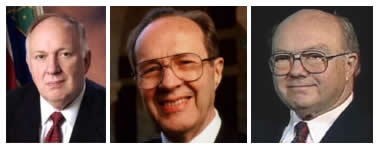 |
| Ambassador Brooks, Secretary Perry and Ambassador Matlock join FAS in call for continuing nuclear transparency under New START treaty |
.By Hans M. Kristensen,
Three former U.S. officials have joined FAS in urging the United States and Russia to continue to declassify the same degree of information about their strategic nuclear forces under the New START treaty as they did during the now-expired START treaty.
The three former officials are: Linton Brooks, former chief U.S. START negotiator and administrator of the National Nuclear Security Administration, Jack Matlock, former U.S. ambassador to the Soviet Union and Special Assistant to President Ronald Reagan for national security affairs, and William Perry, former U.S. Secretary of Defense.
At issue is whether the United States and Russia will continue under the New START treaty to release to the public detailed lists – known as aggregate data – of their strategic nuclear forces with the same degree of transparency as they used to do under the now-expired START treaty. There has been concern that the two countries might reduce the information to only include numbers of delivery systems but withhold information about warhead numbers and locations.
In a joint letter, the three former officials joined FAS President Charles Ferguson and myself in urging the United States and Russia to “continue under the New START treaty the practice from the expired START treaty of releasing to the public aggregate numbers of delivery vehicles and warheads and locations.” This practice contributed greatly to international nuclear transparency, predictability, reassurance, and helped counter rumors and distrust, the letter concludes.
Both governments have stated their intention to seek to broaden the nuclear arms control process in the future to include other nuclear weapon states and the letter warns that achieving this will be a lot harder if the two largest nuclear weapon states were to decide to decrease transparency of their nuclear forces under New START.
“Any decrease in public release of information compared with START would be a step back.”
The letter was sent to Rose Gottemoeller, the U.S. Assistant Secretary of State for Arms Control, Verification and Compliance, and Sergey Kislyak, the Ambassador of the Russian Federation to the United States.
This publication was made possible by a grant from Carnegie Corporation of New York and Ploughshares Fund. The statements made and views expressed are solely the responsibility of the author.
Pakistan’s “Shoot and Scoot” Nukes: FAS Nukes in Newsweek
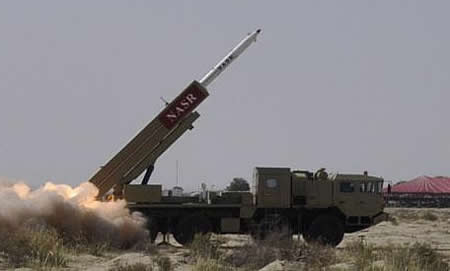 |
| Pakistan’s military describes its new short-range nuclear NASR missile as a “shoot and scoot…quick response system.” Image: ISPR |
.
By Hans M. Kristensen
Andrew Bast at Newsweek was kind enough to use our estimates for world nuclear forces in his latest article on Pakistan growing arsenal.
Of special interest is Pakistan’s production of the NASR (Hatf-9), a worrisome development for South Asia and the decade-long efforts to avoid nuclear weapons being used. With its range of only 60 kilometers, the multi-tube NASR system is not intended to retaliate against Indian cities but be used first against advancing Indian army forces in a battlefield scenario.
Pakistan’s military’s Inter Services Public Relations (ISPR) describes NASR as a system that “carries nuclear warheads of appropriate yield with high accuracy, shoot and scoot attributes” developed as a “quick response system” to “add deterrence value” to Pakistan’s strategic weapons development program “at shorter ranges” in order “to deter evolving threats.”
“Shoot and scoot…quick response system” ??
That sounds like an echo from nuclear battlefields in Europe at the height of the Cold War. It is time for Pakistan to explain how many nuclear weapons, of what kind, and for what purpose are needed for its minimum deterrent.
As bad as it is, though, talk about Pakistan’s nuclear arsenal passing the size of France at some point is, at the current rate, probably one or two decades ahead.
Don’t forget: Pakistan’s nuclear arsenal is not equal to the number of warheads that could potentially be produced by all the highly-enriched uranium and plutonium Pakistan might have produced. The size also depends on other factors such as the number of delivery vehicles and other limitations.
More information in the next Nuclear Notebook scheduled for publications in the Bulletin of the Atomic Scientists on July 1st.
This publication was made possible by a grant from Carnegie Corporation of New York and Ploughshares Fund. The statements made and views expressed are solely the responsibility of the author.
New Article: Russian Nuclear Forces, 2011
 |
| Russia has 3,700-5,400 nonstrategic nuclear weapons, including the old dual-capable AS-4 Kitchen air-launched missile seen here under the wings of a Tu-22 Backfire bomber at an unknown airbase. All Russian nonstrategic warheads are in central storage. Image: web |
.
By Hans M. Kristensen
The latest Nuclear Notebook in the Bulletin of the Atomic Scientists with our updated estimate of Russian nuclear forces is now available via Sage Publications: http://bos.sagepub.com/content/67/3/67.full.pdf+html.
We estimate that Russia currently has nearly 2,430 strategic warheads assigned to operational strategic missiles and bombers, although most of the bomber weapons are probably in central storage. Another 3,700-5,400 nonstrategic warheads are in central storage, of which an estimated 2,080 can be delivered by nonstrategic aircraft, naval vessels and short-range missiles. Another 3,000 warheads are thought to be awaiting dismantlement, for a total inventory of some 11,000 nuclear warheads.
See also: US Nuclear Forces, 2011 | US Tactical Nuclear Weapons in Europe, 2011 | Nonstrategic Nuclear Weapons After the Presidential Nuclear Initiatives (Brief 2011)
This publication was made possible by a grant from Carnegie Corporation of New York and Ploughshares Fund. The statements made and views expressed are solely the responsibility of the author.
Defense Science Board: Air Force Nuclear Management Needs Improvements
 |
| The Defense Science Board recommends reducing the number of inspections of nuclear bomber and missile units. |
.
By Hans M. Kristensen
The Pentagon’s “independent” Defense Science Board Permanent Task Force on Nuclear Weapons Surety has completed a review of the Air Force’s efforts to improve the safety and proficiency of its nuclear bomber and missile units. The report comes three and a half years after the notorious incident at Minot Air Base where six nuclear cruise missiles were mistakenly loaded onto a B-52H bomber and flown across the United States.
The report, Independent Assessment of the Air Force Nuclear Enterprise, finds progress has been made but also identifies some serious issues that still need to be fixed. Some of them are surprising.
Inspections Gone Amok
The most important finding is probably that the nuclear inspection system following Minot has gone amok and in some cases become counterproductive. The number and scope of inspections were increased in response to the incident, but now they have become so frequent and widely applied that nuclear units have neither the time nor resources to correct the deficiencies that are actually identified. Instead the inspection system needs to be limited and focused on where the problems are.
It is natural that leadership will want to demonstrate rigorous efforts to correct deficiencies after a serious incident like Minot by beefing up inspections and exercises as proof that they’re taking things seriously. But this has resulted in a continuous and across-the-board level of inspections and exercise activity that part of the Air Force leadership sees as needed “until a zero-defect culture can be reestablished.”
In reality there has probably never been a zero-defect situation and, when overdone, the high level of inspections and exercises lead to an unrealistic zero-risk mindset. In other words, the leadership needs to cultivate a realistic inspection culture that is focused on detecting and correcting defects rather than expecting to eliminate them.
Over-focus on zero-defect can create distrust in the lower ranks that the leadership doesn’t trust them to perform professionally. This is, the DSB report bluntly concludes, “creating a leadership mindset where satisfying a Nuclear Surety Inspection team, for example, can supplant, or at least compete with, focus on readiness to perform the assigned nuclear mission.”
And nuclear inspection excess combined with multiple over-laying agencies and organizations can create bizarre situations such as in the case of inspections of Munitions Support Squadrons (MUNSSs) in Europe where it is not uncommon to have 80-90 inspectors examining a unit with a total manning of less than 150 personnel.
The report recommends returning gradually to the normal 18-month inspection scheduled used before the Minot incident, and states that additional inspections should occur “only to address unsatisfactory ratings or significant negative trends.” In other words: no additional inspections unless a problem has already been detected.
For the Air Force’s nuclear deployment in Europe, the report recommends that follow‐up re‐inspections and special inspections of air bases and other nuclear units be discontinued unless unsatisfactory ratings or significant negative trends have been identified. For all other discrepancies the wing commander or the MUNSS commander should be accountable for closing out the discrepancies in communication with the appropriate inspection agency. Serious security issues were found at European bases in 2008 and evidently had still not been fixed in 2010.
The DSB report does not, however, describe in detail how or to what extent the nuclear proficiency level has evolved in the nuclear units as a result of the increased inspections and oversight established after 2007. It concludes that a culture of special attention to nuclear issues has been reestablished at the operational level, but not fully at the supporting system of the Air Force nuclear enterprise. It would have been interesting to see how that has affected the actual nuclear inspection grades of the individual units.
Resources Still Lacking
While the Air Force leadership has spoken at length about the importance of improving the nuclear proficiency and safety, the report concludes that the leadership has not yet put the money where its mouth is in terms of prioritizing budgets, upgrades of support equipment, directives and technical orders, and tailoring personnel policies to specific nuclear missions. There is still a degree of business-as-usual in planning and acquisition.
For example, the report identifies that 40-plus year munitions hoists are not being replaced, that engineering requests for reentry vehicles has skyrocketed from 100 in 2007 to 1,100 in 2010, and that repairs of nuclear Weapons Maintenance Trucks (WMTs) at bases in Europe has been delayed by missing spare parts. There are currently 150-200 U.S. nuclear bombs scattered across six bases in five European countries. The 14 WMTs are scheduled for replacement with the Secure Transportable Maintenance System (STMS) in 2014.
Reliability But No Trust
The report concludes that the Air Force’s Personal Reliability Program (PRP), intended to ensure that only qualified people are allowed access to nuclear weapons, has not improved and in some cases increasingly suffers from defects. One problem identified is a continuing escalation of the pursuit of absolute assurance of personal reliability, which the report concludes created “important dysfunctional aspects in the program” where threat of suspension and decertification has produced an environment of distrust. People that have been selected are not sufficiently trustworthy to live an acceptable daily life and must continuously reestablish their credibility. According to the report:
“Even the possibility of Potentially Disqualifying Information (PDI) leads to temporary decertification until it is established that there has been no compromise of reliability. Based on this fundamentally flawed assumption, the PRP repeatedly reexamines the history of each individual.”
“As one example of the consequences of this attitude, personnel are automatically suspended from PRP duties when referred by Air Force medical authorities to off‐base medical treatment regardless of the nature of the referral. The individual must then report to base medical authorities to be reinstated.”
Personnel issues also continue to plague the nuclear wings and MUNSS units in Europe, where the DSB report describes personnel management has created “a flow of people who have no nuclear experience into the key DCA wing in Europe” [i.e. 31st FW at Aviano] and the MUNSS sites at national bases.
As a result, the DSB report recommends that Air Force PRP-based restrictions and monitoring standards be reduced to match those required by DOD.
Command Structure Readjustment
The DBS report also recommends that the nuclear command structure that was set up after the Minot incident be readjusted to that all base-level operations and logistics functions be assigned to the strategic missile and bomb wings reporting through the numbered air forces to Air Force Global Strike Command.
One effect of this command readjustment is the transfer of all munitions squadrons responsible for nuclear mission support from Air Force Material Command to the Air Force Global Strike Command within the next 12 months, recently described by the Air Force.
Download Defense Science Board report
This publication was made possible by a grant from Carnegie Corporation of New York and Ploughshares Fund. The statements made and views expressed are solely the responsibility of the author.
10 NATO Countries Want More Transparency for Non-Strategic Nuclear Weapons
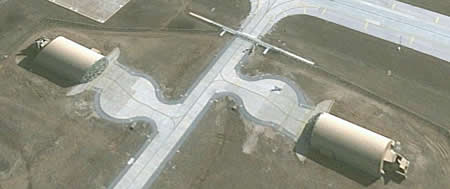 |
| Ten NATO countries recommend increasing transparency of non-strategic nuclear weapons, including numbers and locations at military facilities such as Incirlik Air Base in Turkey. Neither NATO nor Russia currently disclose such information. |
.
By Hans M. Kristensen
Four NATO countries supported by six others have proposed a series of steps that NATO and Russia should take to increase transparency of U.S. and Russian non-strategic nuclear weapons.
The steps are included in a so-called “non-paper” that Germany, the Netherlands, Norway and Poland jointly submitted at the NATO Foreign Affairs Minister meeting in Berlin on 14 April.
Six other NATO allies – Belgium, the Czech Republic, Hungary, Iceland, Luxemburg and Slovenia – also supported the paper.
The four-plus-six group recommend that NATO and Russia:
- Use the NATO-Russia Council (NRC) as the primary framework for transparency and confidence-building efforts concerning tactical nuclear weapons in Europe.
- Exchange information about U.S. and Russian tactical nuclear weapons, including numbers, locations, operational status and command arrangements, as well as level of warhead storage security.
- Agree on a standard reporting formula for tactical nuclear weapons inventories.
- Consider voluntary notifications of movement of tactical nuclear weapons.
- Exchange visits by military officials [presumably to storage locations].
- Exchange conditions and requirements for gradual reductions of tactical nuclear weapons in Europe, including clarifying the number of weapons that have been eliminated and/or stored as a result of the 1991-1992 Presidential Nuclear Initiatives (PNIs).
- Hold a NRC seminar on tactical nuclear weapons in the first quarter of 2012 in Poland.
According to estimates developed by Robert Norris and myself, the United States currently has an inventory of approximately 760 non-strategic nuclear weapons, of which 150-200 bombs are deployed in five European countries. Russia (updated estimate forthcoming soon, previous estimate here) has larger inventory of 3,700-5,400 nonstrategic weapons in central storage, of which an estimated 2,000 are deliverable by nuclear-capable forces.
The proposal comes as the first phase of NATO’s new Defense and Deterrence Posture Review (DDPR) has begun preparation of four so-called scoping papers on 1) the threat facing NATO, 2) the alliance’s strategic mission, 3) the appropriate mix of military forces, and 4) the alliance’s arms control and disarmament policy. The four-plus-six initiative seeks to provide input to the DDPR as well as future work of NATO’s new Weapons of Mass Destruction (WMD) Control and Disarmament Committee. The results of the DDPR are scheduled for approval by the alliance at the summit in March 2012.
Five of the 10 countries supporting the new initiative also were behind an initiative in February 2010 that urged the alliance to include its nuclear policy on the agenda for the NATO meeting in Tallinn in April 2010. The non-paper builds on a previous Polish-Norwegian initiative from April 2010 that is not described.
The Strategic Concept adopted by NATO in November 2010 removed much of the language that previously had identified U.S. non-strategic nuclear weapons in Europe as the trans-Atlantic “glue” in the alliance. Unfortunately, after unilaterally reducing the U.S. weapons in Europe by more than half between 2000 and 2010 and insisting that the deployment was not linked to Russia, NATO reinstated Russia as an official link by concluding in the Strategic Concept that “any” reductions in the U.S. deployment must take into account the disparity with Russian non-strategic nuclear weapons.
The four-plus-six paper does not explicitly call for new cuts and explicitly rejects unilateral reductions. However, it states that transparency and confidence building are “crucial to paving the way for concrete reductions.” To that end the paper is in tune with statements recently made by Gary Samore, Special Assistant to the President and White House Coordinator for Arms Control and Weapons of Mass Destruction, Proliferation, and Terrorism, and by Rose Gottemoeller, Assistant Secretary of State for the Bureau of Arms Control, Verification and Compliance.
I’m an avid supporter of increasing transparency, but given the success of the unilateral Presidential Nuclear Initiatives (PNIs) of 1991-1992 in jumpstarting reductions in non-strategic nuclear weapons without verification, I’m a little concerned about how ready some are to reject unilateral cuts. After all, the United States and NATO have just approved one: retirement of the nuclear Tomahawk land-attack missile (TLAM/N). Rather, transparency, unilateral cuts, and negotiated reductions should all be embraced as tools to move the process forward of reducing the number and role of nuclear weapons.
See: NATO Non-Paper on Non-Strategic Nuclear Weapons
This publication was made possible by a grant from Carnegie Corporation of New York and Ploughshares Fund. The statements made and views expressed are solely the responsibility of the author.
British Submarines to Receive Upgraded US Nuclear Warhead
Sea-launched ballistic missiles on British ballistic missile submarines will be armed with the upgraded W76-1 nuclear warhead currently in production in the United States, according to a report from Sandia National Laboratories.
According to the Labs Accomplishments from March 2011, “the first W76-1 United Kingdom trials test was performed at WETL [Weapon Evaluation Test Laboratory], providing qualification data critical to the UK implementation of the W76-1.”
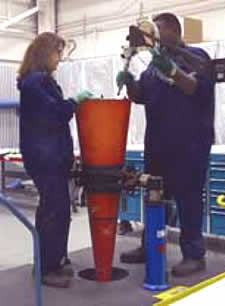
The Royal Navy plans to “integrate” the US W76-1/Mk4A warhead onto British SSBNs.
Rumors have long existed that the nuclear warhead currently used on British sea-launched ballistic missiles (SLBMs) is very similar to the U.S. W76 warhead deployed on American SLBMs. Official sources normally don’t give U.S. warhead designations for the British warhead but use another name. A declassified document published by the National Nuclear Security Administration (NNSA) in 1999, which I published in 2008, described maintenance work on the W76 warhead but called the British version the “UK Trident System.”
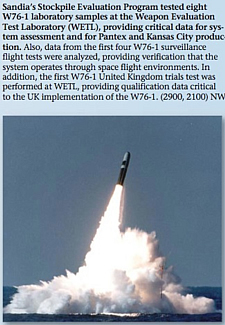 |
| Labs Accomplishments from Sandia National Laboratories describes “the first W76-1 United Kingdom trial test” and “UK implementation of the W76-1.” Download the publication here. |
The Sandia report, on the contrary, explicitly uses the U.S. warhead designation for the warhead on British SLBMs: W76-1.
Approximately 1,200 W76-1s are current in production at the Pantex Plant in Texas. The W76-1 is an upgraded version of the W76-0 (or simply W76) produced between 1978 and 1987. In its full configuration, the upgraded weapon is known as the W76-1/Mk4A, where the Mk4A is the designation for the cone-shaped reentry body that contains the W76-1 warhead.
After first denying it, the British government has since confirmed that the Mk4A reentry body is being integrated onto the British SLBMs but it has been unclear which warhead it will carry: the existing warhead or the new W76-1. The Sandia report appears to show that the United Kingdom will get the full package: W76-1/Mk4A.
HMS Vanguard launches US-supplied Trident II D5 SLBM off Florida in October 2005. In the future, missiles on British submarines will carry US-supplied W76-1/Mk4A nuclear warheads.
The upgrade extends the service life by another 30 years to arm U.S. and British nuclear-powered ballistic missile submarines (SSBNs) through the 2040s. That timeline fits the 2010 British Strategic Defence Review finding that “a replacement warhead is not required until at least the 2030s.”
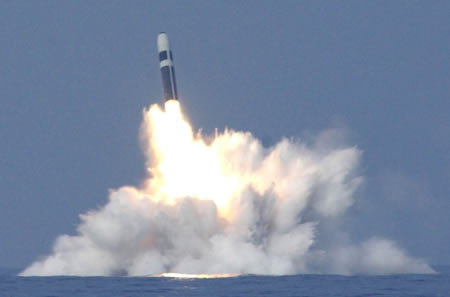 |
| HMS Vanguard launches US-supplied Trident II D5 SLBM off Florida in October 2005. In the future, missiles on British submarines will carry US-supplied W76-1/Mk4A nuclear warheads. |
.
The transfer of W76-1/Mk4A warheads to the United Kingdom further erodes British claims about having an “independent” deterrent. The missiles on the SSBNs are leased from the U.S. Navy, the missile compartment on the next-generation SSBN will be supplied by the United States, and new reactor cores that last the life of future submarines hint of substantial U.S. nuclear assistance.
The transfer of nuclear technology from the United States to Britain is authorized by the 1958 US-UK Mutual Defense Agreement, which was most recently updated in 2004 and extended through 2014 to permit the “transfer of nonnuclear parts, source, byproduct, special nuclear materials, and other material and technology for nuclear weapons and military reactors” between the two countries. The will text is secret but a reconstructed version is here (see note 3).
Acknowledgements: Thanks to Nick Ritchie at Bradford University (“US-UK Special Relationship”) and John Ainslie at Scottish CND.
This publication was made possible by a grant from Carnegie Corporation of New York and Ploughshares Fund. The statements made and views expressed are solely the responsibility of the author.
Report: What NATO Countries Think About Tactical Nukes
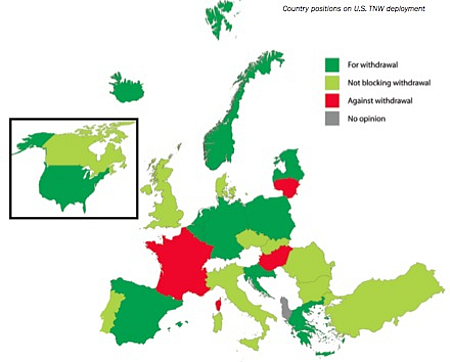 |
| Most NATO countries support withdrawal of U.S. nuclear weapons from Europe, only three oppose, according to interviews with NATO officials. |
.
By Hans M. Kristensen
Two researchers from the Dutch peace group IKV Pax Christi have published a unique study that for the first time provides the public with an overview of what individual NATO governments think about non-strategic nuclear weapons and the U.S. deployment of nuclear bombs in Europe.
Their findings are as surprising as they are new: 14, or half of all NATO member states, actively support the end of the deployment in Europe; 10 more say they will not block a consensus decision to that end; and only three members say they oppose ending the deployment.
Anyone familiar with the debate will know that while there are many claims about what NATO governments think about the need for U.S. weapons in Europe, the documentation has been scarce – to say the least. Warnings against changing status quo are frequent and just yesterday a senior NATO official told me that, “no one in NATO supports withdrawal.”
The report, in contrast, finds – based on “interviews with every national delegation to NATO as well as NATO Headquarters Staff” – that there is overwhelming support in NATO for withdrawal.
The most surprising finding is probably that most of the Baltic States support withdrawal, only Lithuania does not.
Even Turkey, a country often said to be insisting on continued deployment, says it would not oppose a withdrawal.
The only real issue seems to be how a withdrawal would take place. The three opposing countries – one of which is France – block a potential consensus decision, a condition for 10 countries to support withdrawal.
The Obama administration needs to take a much more proactive role in leading NATO toward a decision to end the U.S. deployment in Europe. This can be done without ending extended deterrence and without weakening the U.S. commitment to NATO’s defense.
Background: IKV Pax Christi study | Nuclear Notebook: U.S. Nuclear Weapons In Europe, 2011
This publication was made possible by a grant from Carnegie Corporation of New York and Ploughshares Fund. The statements made and views expressed are solely the responsibility of the author.
New START Data Exchange: Will it Increase or Decrease International Nuclear Transparency?
 |
| U.S. officials say that aggregate numbers of the New START treaty will be made publicly available but that these may be very general numbers and a decision still has to be made. For a copy of the final START aggregate numbers, click here. |
.
By Hans M. Kristensen
The first data exchange of the New START treaty between the United States and Russia has taken place, according to a report by RIA Novosti.
This is the first of more than 20 such data exchanges planned under the treaty for the next 10 years where Russia and the United States twice a year will send each other a list showing how many long-range ballistic missiles and heavy bombers they have and how many nuclear weapons they carry.
But while the exchanges will increase U.S-Russia nuclear transparency, the rest of the world may be facing a future with less information about U.S. and Russian strategic nuclear forces than in the past.
“All exchanges are classified and will not be subject to release,” a U.S. official told me. “There may be some information on very general numbers under the Treaty that could be made public, but that is still to be determined, and will not occur for a least six months if it occurs at all.”
Previous Nuclear Transparency
During the previous START treaty regime between 1994 and 2009, the two countries also exchanged data. That data was classified but the two sides released so-called aggregate numbers biannually to the public (the final START release is here]. Rose Gottemoeller, the U.S. Assistant Secretary for the Bureau of Arms Control, Verification and Compliance, assured early on that “data on the aggregate number of warheads each Party deploys on ICBMs and SLBMs will be exchanged and made publicly available” for New START as well. (Emphasis added)
Hopefully that will happen, but the aggregate numbers release was based on a much larger document – the Memorandum of Understanding (MOU) – exchanged between the two countries twice a year. The unclassified MOU was not published because (I was told) of Russian objections, but the United States would – upon request – release the MOU, which provided much more detailed data for each nuclear weapon and facility.
| START July 2009 Memorandum of Understanding |
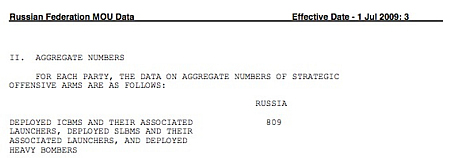 |
| The first START treaty provided the public with detailed overviews of U.S. and Russian strategic nuclear forces. Will New START do so as well or decrease international nuclear transparency? To down copy of the final START MOU, click here. |
.
The MOU provided important information for the international community to monitor the development of U.S. and Russian long-range nuclear forces. But the official statements made so far suggest that such detailed information might not be released under New START.
Implications and Recommendations
The New START treaty is widely seen as a first step in a process that seeks to involve other nuclear weapon states in future nuclear arms control negotiations. As such, it is important that the United States and Russia continue to make detailed information on the status of their nuclear forces available to the international community.
At the very least, this should include the aggregate numbers – including breakdown by individual nuclear weapon systems. But it should also continue the practice of releasing the full unclassified MOUs to increase international transparency and predictability in nuclear forces. Doing anything else would be a step back that could create mistrust and undercut a broadening of the nuclear arms control progress to other nuclear weapon states.
Each new step in the arms control process must increase transparency, not reduce it.
This publication was made possible by a grant from Carnegie Corporation of New York and Ploughshares Fund. The statements made and views expressed are solely the responsibility of the author.
Nuclear Hiccup in South Korea: The Limits of Tactical Nukes
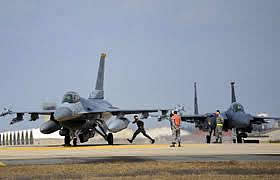 |
| The F-16s (left) of the 8th Fighter Wing at Kunsan Air Base in South Korea lost their nuclear capability in 1991. The F-15Es (right) of the 4th Fighter Wing at Seymour Johnson Air Base in North Carolina no longer are certified for the nuclear strike mission. Instead, extended deterrence is served by conventional forces and long-range nuclear bombers and ballistic missiles. |
By Hans M. Kristensen
In a surprising report, Korea Joongang Daily reported yesterday that White House coordinator for arms control and weapons of mass destruction, Gary Samore, had said that the United States would redeploy nuclear weapons to South Korea if the South Korean government asked for it.
I don’t know what Samore said or meant to say, but the hiccup comes at particularly bad time after two North Korean nuclear tests, its suspected sinking of a South Korean warship and the shelling of Yeonpyeong island, and repeated large-scale U.S.-South Korean military exercises, all of which have raised tension on the troubled Korean Peninsula again.
Fortunately the White House quickly corrected the record, explaning that “tactical nuclear weapons are unnecessary for the defense of South Korea and we have no plan or intention to return them” to the country.
It is particularly important that the rebuttal included more than “we have no plan” but also reiterated the fact that tactical nuclear weapons are “unnecessary” for the defense of South Korea.
As a consequence, the U.S. Air Force has over the past several years phased out the nuclear mission of two fighter wings in the United States that previously were tasked to forward deploy to Europe or Asia with tactical nuclear weapons (an example of a nuclear exercise in 1998 is available here). The F-15E aircraft of one of the wings, the 4th Fighter Wing at Seymour Johnson Air Base in North Carolina, are still considered nuclear capable but are no longer nuclear certified. Instead, the extended deterrence mission in Asia is, as it should be, served by forward-deployed conventional and long-range nuclear forces.
That tactical nuclear weapons are not necessary to defend a key ally is a fact that NATO should learn from. Nearly 200 U.S. tactical bombs are stuck in Europe because the alliance can’t figure out how to do what South Korea did 20 years ago. All the more strange because NATO, unlike South Korea, doesn’t have a large military threat right next door.
Background: A History of US Nuclear Weapons in South Korea
This publication was made possible by a grant from Carnegie Corporation of New York and Ploughshares Fund. The statements made and views expressed are solely the responsibility of the author.
Talk at Georgetown U Event on Tac Nuke Treaty
By Hans M. Kristensen
The Center on National Security and the Law and the Federal Legislation and Administrative Clinic co-hosted an event at Georgetown University Law Center on Tuesday, March 1st: Next Steps after New START: A Treaty on Tactical Nuclear Weapons.
The event included a keynote speech by Edward Warner, the Senior Advisor to the under Secretary of Defense for Policy.
I gave a briefing on the status of US and Russian nonstrategic nuclear weapons. Other panelists included Michael May, former director of Lawrence Livermore National Laboratory and now at Stanford University, Paul Dean from the Department of State, Madelyn Creedon with the Senate Armed Services Committee, and Tim Morrison from the office of Senator Jon Kyl. Dakota Rudesill from the Law Center moderated.
This publication was made possible by a grant from Carnegie Corporation of New York and Ploughshares Fund. The statements made and views expressed are solely the responsibility of the author.
Air Force Magazine Prints Nuke Chart
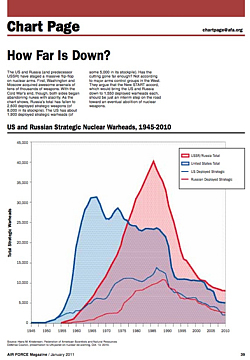 |
By Hans M. Kristensen
The January 2011 issue of Air Force Magazine has a nice spread on the Chart Page where they reproduce a chart I produced of U.S. and Russian nuclear warhead inventories.
The chart is the product of the research and public education I do about the status of nuclear forces in collaboration with the nuclear program over at the Natural Resources Defense Council.
This chart was initially used in a de-alerting briefing at the United Nations last October.
This publication was made possible by a grant from Carnegie Corporation of New York and Ploughshares Fund. The statements made and views expressed are solely the responsibility of the author.
The Nuclear Weapons Modernization Budget

The FY2012 budget request includes considerable nuclear weapon modernization
By Hans M. Kristensen
The Obama administration has published its budget request for Fiscal Year 2012, which includes its plans for maintaining and modernizing its nuclear weapons arsenal.
Due to the extensive debate about the New START treaty last year a great deal of the nuclear plans were already known. And the budget request demonstrates that the administration follows through on its promise to modernize the U.S. nuclear weapons arsenal and production facilities.
How this modernization effort will color the administration’s public nuclear legacy remains to be seen.
Warhead Maintenance and Modernization
The budget includes significant investments in maintaining and modernizing the nuclear weapons in the stockpile through the life-extension programs (LEPs). Including the costs from FY2011, the administration plans to spend $6.3 billion through FY2016 on the warheads in the stockpile. Additional LEPs are planned after 2016 (see Stockpile Stewardship Management Plan).
Determining what portion of these costs will be spent on LEPs is difficult because LEP costs for each warhead in the budget are included in the stockpile costs until the LEP gets full go-ahead. That means that stockpile costs are significantly ballooned for some years. When compensating for this accounting rule, the total cost for LEP work in FY2011 through FY2016 is roughly $4.9 billion.
There are three primary LEPs in the budget involving the B61, W76, and W78 warheads. The W88 is also undergoing a small LEP to replace the Arming, Fuzing and Firing (AF&F) unit. Details of the LEPs are:
W76 LEP: Production of W76-1 at the Pantex Plant in Texas is well underway after start-up problems. The first warhead was produced in 2008 and warheads are now being delivered to the navy and deployed on Trident II D5 ballistic missiles. Full-scale production will be achieved in 2013 and continue through 2018. The FY2012 budget request shows $1.5 billion spent on the LEP through FY2016. The LEP extends the life of the warhead for another 30 years and adds new safety features and improves the military capability of the W76.
B61 LEP: Production of a new B61 version called the B61-12 will begin in FY2017 and increase during FY2018 as the W76 production fades out and continue through FY2022. The B61-12 will combine three older B61 versions (B61-3/4/7) into one. The consolidation was previously also scheduled to include the B61-10, a converted W85 Pershing II warhead, but the B61-10 has recently been retired. The B61-12 will reuse the B61 plutonium pit for the primary and reuse or remanufacture the B61-4 secondary. The modification will extend the life of the B61 for another 30 years.
The budget states that the new version will have better reliability, enhanced margin against failure, increasing safety, and improving security and use control. The budget also states that, “insensitive high explosives could replace conventional high explosives,” a curious statement given that the government has previously stated that the remaining B61 versions already have insensitive high explosives.
 |
| The B61-12 will be based on components from three different B61 types: B61-3, B61-4 and B61-7. The secondary will be from the B61-4 or remanufactured. Although the NNSA budget mentions replacing conventional high explosives with insensitive high explosives, all stockpiled B61s already have insensitive high explosives. |
.
W78 LEP: This warhead program is evolving into a whole new experiment with the plan to develop a “common high-surety warhead” for deployment of the Minuteman III ICBMs and Trident II D5 SLBMs. Studies are still defining the full scope of this warhead but it includes new safety and use-control features. A new AF&F will “maximize” use of the fuze program for the navy’s Mk5/W88 program. Approximately $1 billion is budgeted for this LEP through FY2016, but the program extends well beyond 2025 with significant additional costs.
W87: The budget also shows that a new AF&F for the Mk21/W87, the second warhead on the Minuteman III, is being considered to match the W78 LEP. Like the common warhead, this will also maximize use of Mk5 fuze program elements.
W88: Although not yet scheduled to under a full LEP, the Mk5/W88 is undergoing a crash program to replace its AF&F unit. Fuzes are very expensive, and the budget includes roughly $432 million through FY2016. This new fuze technology will probably form the basis for the new fuze planned for the W78 and W87.
The navy budget also indicates development of an advanced radiation-hardened GPS receiver for ballistic missile reentry bodies, a technology that would be required for maneuverable warheads. A flight test of the GPS unit is scheduled for FY2011.
The dismantling of retired warheads does not appear to be a priority for the Obama administration. There are several thousand retired warheads – probably around 3,500 – in storage awaiting dismantlement. Most were retired during the reduction of the stockpile by nearly half in 2004-2007, but the annual dismantlement budget will be less than in 2010 and comparable to that of the Bush administration. The $56.8 million scheduled for FY2012 is a 40% reduction compared with FY2010. At the planned rate, all warheads retired prior to FY2010 will be dismantled by 2022.
Nuclear Delivery Vehicles
In addition to modernizing the warheads and the production complex, the Obama administration has also pledged to spend “well over 100 billion dollars” on modernizing some of the missiles, submarines and bombers designed to deliver the warheads.
Ballistic missile submarine: The next class of ballistic missile submarines – commonly called SSBN(X) – is called Sea Based Strategic Deterrent (SBSD) Advanced Submarine System Development (ASSD) in the budget. The budget includes $781.6 million in FY2012 and shows $5.1 billion through FY2010-FY2016.
 |
| The next SSBN class will have 16 missile tubes, unlike the Ohio-class seen here, which has 24 tubes. The first unit is scheduled to enter service in 2029, carry a life-extended version of the Trident II D5 SLBM, and be in service through the 2080s. |
.
The SSBN development strategy is to maximize re-use of existing Ohio-class SSBN systems and new designs from Virginia-class SSNs.
The budget does not specify the number of missile tubes per submarine, but the Defense Acquisition Board decided in December 2010 that the new design should have 16 tubes. The navy purchased another 24 D5LE missiles in FY12.
The previous ambition to deploy conventional warheads on SLBMs has suffered many setbacks but lives on in the new budget, although only as a study to examine the ambiguity issues involved in launching conventional weapons from a nuclear strike platform and “better understand the capabilities that could be delivered from naval platforms.”
Land-based missiles: There is no money listed in the budget for the initial study of alternatives promised by the Nuclear Posture Review, but a small amount – $2.6 million – are included to study current or “future ICBM weapon systems.” But with the intension to extend the service life of the Minuteman III ICBM through at least 2030 – possibly longer – it is too early for a new missile to appear in the budget. The Minuteman III is in the final phase of a decade-long upgrade that has replaced all major components; it is essentially a new missile.
Efforts to equip ICBMs with conventional warheads continue, and a conventional strike mission integration demonstration study is scheduled for completion at the end of FY2011.
Heavy bombers: Both B-2 and B-52 are being upgraded for the new Advanced Extremely High Frequency (AHEF) satellite constellation, and to equip the bombers with additional nuclear hardening.
The B-2 will be equipped to carry the new B61-12 gravity bomb. The B-52 is undergoing a Reconstitution Study that will provide for further nuclear weapons in both bay and under wings. One of these is the Long Range Stand-Off (LRSO) cruise missile intended to replace the Air Launched Cruise Missile (ALCM) in 2030. The warhead might be the W80-3, a modified LEP version of the current W80-1. Nearly $10 million are scheduled to study the new missile in FY2012, with a total of $884,297 million through FY12-16.
The budget does not present a schedule for the next generation bomber, but it is in design development with $197,023 earmarked for FY2012 and $3.94 billion through FY2016. [Update: According to The Hill, Pentagon comptroller Robert Hale stated that the plan is to build 80-100 new bombers to replace the B-2 and B-52H. Only a portion of these would, presumably, become nuclear-capable.]
Fighter-bombers: The budget gives new details about the scope and nuclear capability of the Joint Strike Fighter. Follow-on development will be initiated of the F-35A CTOL Variant Air Vehicle for dual-capability (DCA). DCA integration is scheduled for FY2011-FY2017 with nuclear capability added in the first post-SDD (System Development and Demonstration) block upgrade (Block IV). F-35A will have capability to carry two B61s internally. There are $10 million budgeted for FY2012 with $262.7 million through FY2016 to support Joint Strategic Capabilities Plan (JSCP) requirements from FY2017.
 |
| The F-35A CTOL (conventional take off and landing) will be capable of carrying two B61-12 nuclear bombs, one in each bay. |
.
The F-35A Block IV will replace the F-15E and F-16 in the nuclear mission and also be offered to NATO allies that are tasked to deliver U.S. nuclear weapons.
Nuclear Factories
The budget provides new cost estimates for the two new nuclear weapons production factories that are under construction; the CMRR (Chemistry and Metallurgy Research Replacement) facility at Los Alamos National Laboratory in New Mexico, and the UPF (Uranium Production Facility) at the Y-12 complex in Oak Ridge, Tennessee. Both factories are already over budget.
Based on 45% design completion, the CMRR is now estimated to cost $3.7-$5.8 billion to complete. The UPF is estimated at $4.2-$6.5 billion. A total of $9.9-$12.3 billion. But even this is probably too low and NNSA promises that a new estimate will come in FY2013 after the factories reach 90% design completion. Full operation of the two factories is planned for FY2023 and FY2024, respectively. GAO recently concluded that NNSA has very poor basis for making realistic cost estimates.
Implications and Outlook
With massive investments in widespread modernization of nuclear forces and industry, the FY2012 budget shows that the Obama administration is following through on its promise to make significant investments in modernizing the U.S. nuclear deterrent.
The “generational” modernizations proposed in the budget represent a commitment to extending the nuclear era as long into the future as it has lasted so far. A challenge will be whether nuclear modernization will overshadow nuclear disarmament in the administration’s public nuclear image.
Following on the heels of the Prague speech and the New START treaty, it remains to be seen whether other nuclear weapon states and the international non-proliferation community will see the nuclear modernization programs as progress toward reducing the role and numbers of nuclear weapons and putting an end to Cold War thinking, or business as usual only at lower numbers.
To what extent the Congress will fund these programs is another unknown. With unprecedented deficit and a new Congress that appears determined to cut government spending, several of the nuclear modernization programs will like come under considerable scrutiny.
This publication was made possible by a grant from Carnegie Corporation of New York and Ploughshares Fund. The statements made and views expressed are solely the responsibility of the author.
